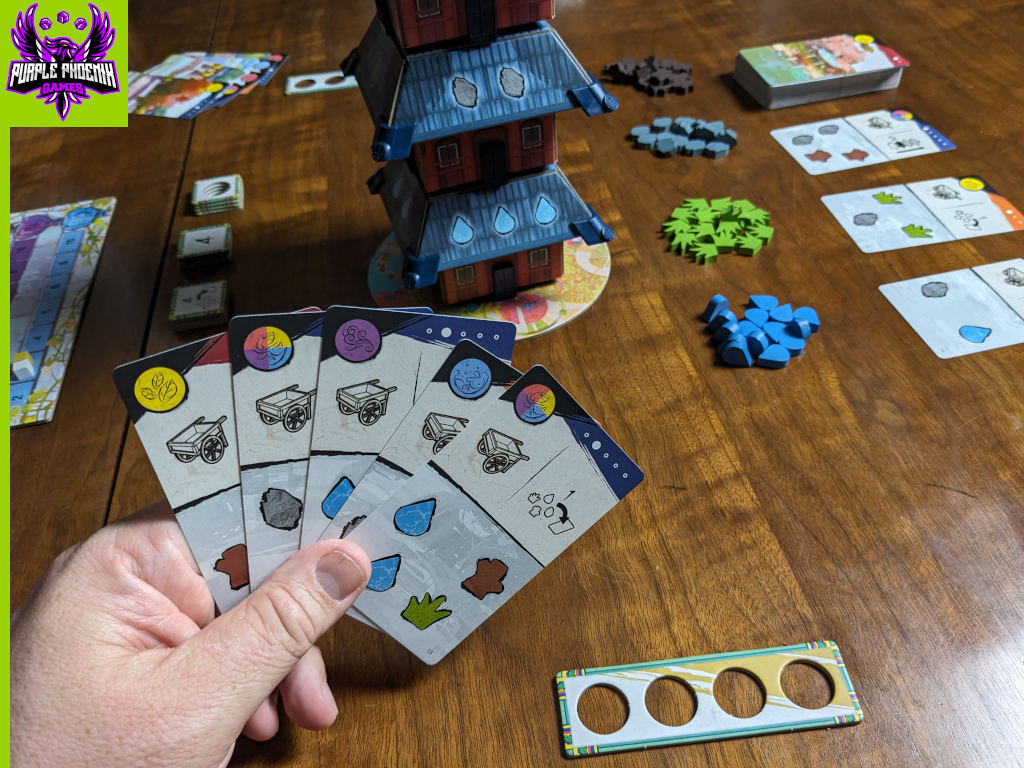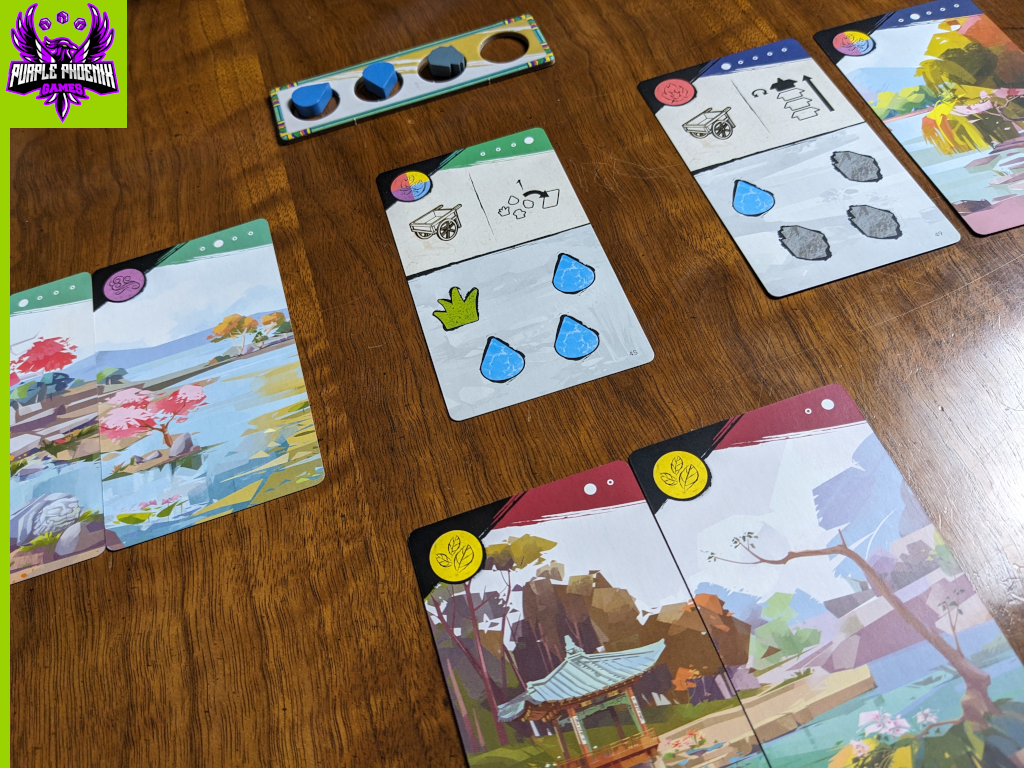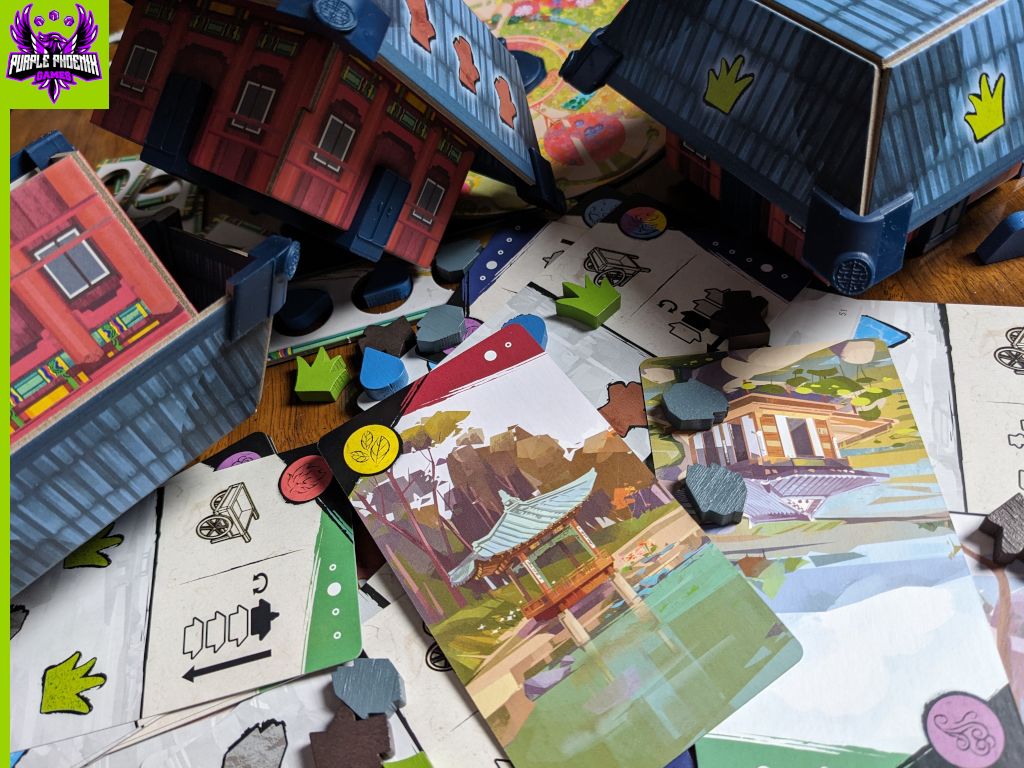
I have a disease called “wanderlust” that keeps me wanting to visit different areas of the world. One such area is the beautiful and ancient lands of Asia. My father has traveled to certain Asian countries and has told of amazing buildings, culture, and people. I know very little of the architectural styles and significance of specific angles or materials used – I just know a pretty building when I see one. Given the chance to review Four Gardens from Arcane Wonders is simply fuel for my fire to get out there and bask in the beauty of Asia as soon as I can.
| Four Gardens (2020) | Arcane Wonders/Korea Boardgames |
| 2-4 Players | 45 minutes |
| Ages 10+ | BGG Weight – 2.29 / 5 |
Four Gardens is a set collection, hand management game with a very impressive resource gimmick – a rotating three-dimensional pagoda! In this game, players will be attempting to construct the most beautiful gardens around the central pagoda that is dedicated to four (nonspecific) gods. The player who can do this best (by collecting the most VP) will be crowned the next Queen of (insert nondiscript Asian country/province/queendom here)!
DISCLAIMER: We were provided a copy of this game for the purposes of this review. This is a retail copy of the game, so what you see in these photos is exactly what would be received in your box. I do not intend to cover the variant rules included in the rulebook, but will describe the overall game flow and major rule set so that our readers may get a sense of how the game plays. For more in depth rules, you may purchase a copy online or from your FLGS. -T
DISCLAIMER 2: My wife and I have recently moved into a new home and I have been unable to find my fancy purple tablecover. So you get photos on a naked table. This time at night with a solitary softbox. Sorry. – T
To setup, build the pagoda per the rules insert, place it on the table between all players so that one of the four sides is facing each player. Shuffle the cards and deal each player a hand of five. The remaining deck will form the draw deck. Place out three cards from the draw deck to form the offer row. The resourceeples are placed on the table along with the Bonus Tiles and Scoreboard. Each player chooses a color, is given that color’s Planning Tiles, and their Score Markers are placed upon the Scoreboard starting at 3 VP for each god track. The game may now begin!

On a turn the active player will complete three total actions from a selection of four actions, with any action able to be repeated. These actions are Lay Groundwork, Rotate & Collect, Take a Wild, and Reallocate Resources. Each double-sided card shows a completed garden (mural pane) on one side and a multipurpose collection of icons on the reverse. In order to complete (and score) a card, the active player will need to Lay Groundwork by placing one card from hand with the icon side face-up. This is effectively stating that the card is under construction. Only when all icons on the bottom half of the card are covered with matching resourceeples will the card be able to graduate to a lovely garden section by flipping it over and scoring. When flipping a completed card, the player will note which god it pleases by raising their score on the Scoreboard according to the color of god found in the circular icon in the upper left corner of the garden side. However, once one or more mural panels have been flipped, each time a new card is added to the matching garden, the new card scores AS WELL AS all other cards belonging to that garden.
Card icons will need to be covered by the wood, stone, water, and grass resourceeples. These can be received by taking the Rotate & Collect action. By discarding a card from hand, the active player uses the pagoda icon in the upper right corner to turn a specific level of the pagoda (along with all levels above it) 90 degrees in either direction and then collecting the resources according to the face values and limited by the number of open spaces in the player’s Planning Tile (the board with four holes). Some cards will have the player collecting from the bottom floor upwards, while others will begin collecting from the top level downward. One additional way to gather resources is by utilizing the Take a Wild icon found on some cards in that same location. This simply means the player may choose ANY ONE resource from the supply to immediately place on one of their cards under construction. Both of these card and icon examples are found in the photo below.
The final action that may be taken on a turn is to Reallocate Resources. The player does this by discarding any card from hand to use its wheelbarrow icon found in the upper left corner. This icon symbolizes the ability to move resources around however the player wishes. Most of the time it will be to move resources from the Planning Tile onto a card under construction, but also allows for resources to be moved from one card to another, or to discard resources from the Planning Tile to the supply altogether. Again, once a card under construction has all the required resources place on it, the player must flip it and score.
After the active player has taken their three actions (and tracked by leaving the player with only two cards in hand) they will need to replenish their hand by selecting cards from the offer row or blindly from the top of the draw pile. The offer row is not immediately refilled, but only after the replenishing is completed. It is now the next player’s turn. The game continues in this fashion until a set number of garden cards have been flipped per number of players (found in a table in the rulebook). The winner is then crowned Queen of… whatever you want to name it!

Components. Obviously, the most impressive component in this game is the strikingly beautiful 3D pagoda. On each level is printed one of the resources, with each side of a level showing 0, 1, 2, or 3 of the resource to be gained by players on their turns. The best part about this pagoda is that it can be randomized before each play session so that the order is fresh each time. It is super sturdy and will definitely hold up to multiple multiple plays and I’m excited to see how many plays I can get in before I will have to replace mine. All other cardboard components are of similar thickness and quality. The cards are all easy to read and of great quality as well. The cutie little resourceeples are fun to throw around. My one qualm is that I wish the scoring cubes were bigger. I’m a bigger dude and these things are like the size of 1/4 my pinky fingernail. I may bring some D&D minis for my scores in the future…
Now, I have left some fun rules out of my recap for y’all to experience, and gauging by my rating up top, you can tell that I think this is an absolute GEM. Everything about the gameplay is everything I love about games – hand management, set collection, offer row, no player powers, and no party games. The gimmick is so gimmicky and I absolutely ADORE it. The levels move very freely and it doesn’t feel cheap at all. Every turn can be painstaking, and I would caution playing with AP-prone opponents as it may have them crunching too much for a more flowing game like this.
The scoring is creative, and the freedom of being able to build one’s garden in almost any order is very welcome. Though Four Gardens involves a bit of risk/reward and misfortune mitigation in the pagoda state on your turn, I genuinely FEEL great playing it. Many gamers say that playing a game like Tokaido can be a very leisurely and relaxing experience, and while I agree, I would also place this in the same conversation. There is certainly more meat here, but the feeling of accomplishment at game end is very rewarding. Purple Phoenix Games officially awards Four Gardens with a great score of 11 / 12, but I am hoping I can get Laura to increase her score with more and more plays of it. I don’t know if this will break into my Top 10 Games of All Time, but I wouldn’t necessarily be sad or surprised to see it knocking at that door. Grab yourself a copy of this great game and let me know if you agree with me.

